Leopard
From Wikipedia, the free encyclopedia
"Leopards" redirects here. For other uses, see Leopards (disambiguation).
For other uses, see Leopard (disambiguation) and Leopardi (disambiguation).
| Leopard Temporal range: Late Pliocene or EarlyPleistocene to Recent | |
|---|---|
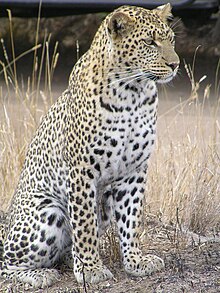 | |
| Conservation status | |
| Scientific classification | |
| Kingdom: | Animalia |
| Phylum: | Chordata |
| Class: | Mammalia |
| Order: | Carnivora |
| Family: | Felidae |
| Genus: | Panthera |
| Species: | P. pardus |
| Binomial name | |
| Panthera pardus (Linnaeus, 1758) | |
 | |
| Range of the leopard, former[when?] (red), present (green), and uncertain (yellow) | |
| Synonyms | |
Felis pardus Linnaeus, 1758 | |
The leopard ( /ˈlɛpərd/), Panthera pardus, is a member of the Felidae family and the smallest of the four "big cats" in the genus Panthera, the other three being the tiger, lion, and jaguar. The leopard was once distributed across eastern and southern Asia and Africa, from Siberia to South Africa, but its range of distribution has decreased radically because of hunting and loss of habitat. It is now chiefly found in sub-Saharan Africa; there are also fragmented populations in the Indian subcontinent, Sri Lanka, Indochina, Malaysia, Indonesia, and China. Because of its declining range and population, it is listed as a "Near Threatened" species on the IUCN Red List.[1]
/ˈlɛpərd/), Panthera pardus, is a member of the Felidae family and the smallest of the four "big cats" in the genus Panthera, the other three being the tiger, lion, and jaguar. The leopard was once distributed across eastern and southern Asia and Africa, from Siberia to South Africa, but its range of distribution has decreased radically because of hunting and loss of habitat. It is now chiefly found in sub-Saharan Africa; there are also fragmented populations in the Indian subcontinent, Sri Lanka, Indochina, Malaysia, Indonesia, and China. Because of its declining range and population, it is listed as a "Near Threatened" species on the IUCN Red List.[1]
Compared to other members of the Felidae family, the leopard has relatively short legs and a long body with a large skull. It is similar in appearance to the jaguar, but is smaller and more slightly built. Its fur is marked with rosettes similar to those of the jaguar, but the leopard's rosettes are smaller and more densely packed, and do not usually have central spots as the jaguars do. Both leopards and jaguars that are melanistic (completely black or very dark) are known as black panthers.
The species' success in the wild is in part due to its opportunistic hunting behavior, its adaptability to habitats, its ability to run at speeds approaching 58 kilometres per hour (36 mph), its unequaled ability to climb trees even when carrying a heavy carcass,[2] and its notorious ability for stealth. The leopard consumes virtually any animal that it can hunt down and catch. Its habitat ranges fromrainforest to desert terrains.
Contents[hide] |
[edit]Characteristics
Leopards are agile and stealthy predators. Although smaller than other members of the Pantheragenus, they are able to take large prey due to their massive skulls that facilitate powerful jaw muscles. Head and body length is between 95 and 165 cm (37 and 65 in), and the tail reaches 60 to 110 cm (24 to 43 in).[3] Shoulder height is 45 to 80 cm (18 to 31 in). The muscles attached to the scapula are exceptionally strong, which enhance their ability to climb trees. They are very diverse in size. Males are about 30% larger than females, weighing 30 to 91 kg (66 to 200 lb) compared to 23 to 60 kg (51 to 130 lb) for females. Large males of up to 91 kg (200 lb) have been documented in Kruger National Park in South Africa; however, males in the South Africa's coastal mountains average 31 kg (68 lb) and the females from the desert-edge in Somalia average 23 to 27 kg (51 to 60 lb). This wide variation in size is thought to result from the quality and availability of prey found in each habitat. The most diminutive leopard subspecies overall is the Arabian leopard (P. p. nimr), from deserts of the Middle East, with adult females of this race weighing as little as 20 kg (44 lb).[4]
Other large subspecies, in which males weigh up to 91 kg (200 lb), are the Sri Lankan leopard (P. p. kotiya) and theAnatolian leopard (P. p. tulliana).[5] The largest verified leopards weighed 96.5 kg (213 lb). Larger sizes reported are considered unreliable.[6] The leopard's body is comparatively long, and its legs are short.[7]
Leopards show a great diversity in coat color and rosette patterns. Their rosettes are circular in East Africa but tend to be squarer in southern Africa and larger in Asian populations. Their yellow coat tends to more pale and cream colored in desert populations, more gray in colder climates, and of a darker golden hue inrainforest habitats. Overall, the fur under the belly tends to be lighter coloured and of a softer, downy type. Solid black spots in place of open rosettes are generally seen along the face, limbs and underbelly.[4]
Leopards may sometimes be confused with two other large spotted cats, the cheetah, with which it may co-exist in Africa, and the jaguar, a neotropical species that it does not naturally co-exist with. However, the patterns of spots in each are different: the cheetah has simple black spots, evenly spread; the jaguar has small spots inside the polygonal rosettes; while the leopard normally has rounder, smaller rosettes than those of the jaguar. The cheetah has longer legs and a thinner build that makes it look more streamlined and taller but less powerfully built than the leopard. The jaguar is more similar in build to the leopard but is generally larger in size and has a more muscular, bulky appearance.[8]
[edit]Variant coloration
Melanistic leopards are commonly called black panthers, a term that also applies to melanisticjaguars. Pseudomelanism (abundism) also occurs in leopards.[9] Melanism in leopards is inherited as a Mendelian, monogenic recessive trait relative to the spotted form. Pairings of black animalsinter se have a significantly smaller litter size than other possible pairings.[10] The black color is caused by recessive gene loci.[11]
The black panther is common in the equatorial rainforest of Malaya and the tropical rainforest on the slopes of some African mountains such as Mount Kenya.[12] Between January 1996 and March 2009, Indochinese leopards were photographed at 16 sites in the Malay Peninsula in a sampling effort of more than 1000 trap nights. Of 445 photographs of melanistic leopards taken, 410 came from study sites south of the Isthmus of Kra, where the non-melanistic morph was never photographed. These data suggest the near fixation of the dark allele in the region. The expected time to fixation of this recessive allele due to genetic drift alone ranged from about 1,100 years to about 100,000 years.[13][14]
Melanism in leopards has been hypothesized to be causally associated with a selective advantage for ambush.[15]
[edit]Etymology
In antiquity, a leopard was believed to be a hybrid of a lion and a panther, as is reflected in its name, which is a Greek compound of λέων leōn (lion) and πάρδος pardos (male panther). The Greek word is related to Sanskrit पृदाकु pṛdāku (snake, tiger, panther), and probably is derived from a Mediterranean language, such as Egyptian.[16][17]
A panther can be any of several species of large felids: the term can refer to cougars and jaguars in the American continents; and everywhere else, to leopards.[18]
The generic component of its modern scientific designation, Panthera pardus, is derived from Latin via Greek πάνθηρ (pánthēr).[19] Folk etymology held that it was a compound of παν (pan, all) and θηρ (beast).[20] However, it is believed instead to be derived from an Indo-Iranianword meaning "white-yellow, pale"; in Sanskrit, this word's reflex was पाण्डर pāṇḍara, which was derived from पुण्डरीक puṇḍárīka (tiger, among other things), then borrowed into Greek.[17][19]
[edit]Taxonomy and evolution
Like all of the feline family, the Panthera genus has been subject to much alteration and debate, and the exact relations between the four species as well as the clouded leopard and snow leopard have not been effectively resolved.
The leopard was among the first animals named under the modern system of biological classification, since it was described by Carl Linnaeus in 1758 in the 10th edition of Systema Naturae. Linnaeus placed the leopard under the genus Felis as the binominal Felis pardus.[21] In the 18th and 19th centuries, most naturalists and taxonomists followed his example. In 1816, Lorenz Oken proposed a definition of the genus Panthera, with a subgenus Panthera using Linnaeus' Felis pardus as a type species. But most disagreed with his definition, and until the beginning of the 20th century continued using Felis or Leopardus when describing leopard subspecies.[22] In 1916,Reginald Innes Pocock accorded Panthera generic rank defining Panthera pardus as species.[23]
It is believed that the basal divergence amongst the Felidae family occurred about 11 million years ago. The last common ancestor of the lion,tiger, leopard, jaguar, snow leopard, and clouded leopard is believed to have occurred about 6.37 million years ago. Panthera is believed to have emerged in Asia, with ancestors of the leopard and other cats subsequently migrating into Africa. The researchers suggest that the snow leopard is most closely aligned with the tiger, whereas the leopard possibly has diverged from the Panthera lineage subsequent to these two species, but before the lion and jaguar.[24]
Results of phylogenetic analyses of chemical secretions amongst cats has suggested that the leopard is closely related to the lion.[25]Results of a mitochondrial DNA study carried out later suggest that the leopard is closely related to the snow leopard, which is placed as a fifth Panthera species, Panthera uncia.[26]
[edit]Fossil records
Fossil leopard bones and teeth dating from the Pliocene were found in Perrier in France, northeast of London, and in Valdarno in Italy. At 40 sites in Europe fossil bones and dental remains of leopards dating from the Pleistocene were excavated mostly in loess and caves. The sites of these fossil records range from near Lisbon, near Gibraltar, and Santander Province in northern Spain to several sites in France,Switzerland, Italy, Austria, Germany, in the north up to Derby in England, in the east to Přerov in the Czech Republic and the Baranya in southern Hungary.[27]
Fossils of early leopard ancestors have been found in East Africa and South Asia from the Pleistocene of 2 to 3.5 Ma. The modern leopard is suggested to have evolved in Africa 470,000–825,000 years ago and radiated across Asia 170,000–300,000 years ago.[28]
[edit]Distribution and habitat
Leopards have the largest distribution of any wild cat, occurring widely in eastern and centralAfrica, although populations have shown a declining trend and are fragmented outside of sub-Saharan Africa. Within sub-Saharan Africa, the species is still numerous and even thriving in marginal habitats where other large cats have disappeared. But populations in North Africa may beextinct.[4]
Data on their distribution in Asia are not consistent — populations in southwest and central Asia are small and fragmented; in the northeast, they are critically endangered; but in the Indian subcontinent, Southeast Asia, and China, leopards are still relatively abundant. Of the species as a whole, its numbers are greater than those of other Panthera species, all of which face more acute conservation concerns.[1]
Leopards live mainly in grasslands, woodlands, and riverine forests. They are usually associated with savanna and rainforest, but leopards are exceptionally adaptable: in the Russian Far East, they inhabit temperate forests where winter temperatures reach a low of −25 °C (−13 °F).[28]
[edit]Distribution of subspecies
Since Carl Linnaeus published his description of leopards in the 10th edition of Systema Naturaein 1758, as many as 27 leopard subspecies were subsequently described by naturalists from 1794 to 1956. In 1996, according to DNA analysis carried out in the 1990s, only eight subspecies are considered valid.[29] Later analysis revealed a ninth valid subspecies, the Arabian leopard (P. p. nimr). Because of limited sampling of African leopards, this number might be an underestimation.[28]
- African leopard (P. p. pardus), (Linnaeus, 1758) — inhabits sub-Saharan Africa;
- Indian leopard (P. p. fusca), (Meyer, 1794) — inhabits the Indian Subcontinent;
- Javan leopard (P. p. melas), (Cuvier, 1809) — inhabits Java, Indonesia.
- Arabian leopard (P. p. nimr), (Hemprich and Ehrenberg, 1833) — inhabits the Arabian Peninsula;
- Amur leopard (P. p. orientalis), (Schlegel, 1857) — inhabits the Russian Far East, Korean Peninsula and Northeast China;
- North Chinese leopard (P. p. japonensis), (Gray, 1862) — inhabits northern China;
- Caucasian leopard (P. p. ciscaucasica), (Satunin, 1914), later described as Persian leopard(P. p. saxicolor), (Pocock, 1927) — inhabits central Asia: the Caucasus, Turkmenistan and northern Iran;[30]
- Indochinese leopard (P. p. delacouri), (Pocock, 1930) — inhabits mainland Southeast Asia;
- Sri Lankan leopard (P. p. kotiya), (Deraniyagala, 1956) — inhabits Sri Lanka.
A morphological analysis of characters of leopard skulls implies the validity of two more subspecies:[30]
- Anatolian leopard (P. p. tulliana), (Valenciennes, 1856) — inhabits Western Turkey;
- Balochistan leopard (P. p. sindica), (Pocock, 1930) — inhabits Pakistan, and possibly also parts of Afghanistan and Iran.
[edit]Ecology and behavior
Leopards are elusive, solitary and largely nocturnal.[31] They have primarily been studied in open savanna habitats, which may have biased common descriptions. Activity level varies depending on the habitat and the type of prey that they hunt. Radio-tracking and scat analysis in West Africa showed that rainforest leopards are more likely to be diurnal and crepuscular. Forest leopards are also more specialized in prey selection and exhibit seasonal differences in activity patterns.[32]
Leopards are known for their ability in climbing, and have been observed resting on tree branches during the day, dragging their kills up trees and hanging them there, and descending from trees headfirst.[33] They are powerful swimmers, although not as strong as some other big cats, such as the tiger. They are very agile, and can run at over 58 kilometres per hour (36 mph), leap over 6 metres (20 ft) horizontally, and jump up to 3 metres (9.8 ft) vertically.[34] They produce a number of vocalizations, including grunts, roars, growls, meows, and "sawing" sounds.[35]
[edit]Social structure and home range
Home ranges of male leopards vary between 30 km2 (12 sq mi) and 78 km2 (30 sq mi), and of females between 15 to 16 km2 (5.8 to 6.2 sq mi).[4] Virtually all sources suggest that males do have larger home ranges. There seems to be little or no overlap in territory among males, although overlap exists between the sexes; one radio-collar analysis in the Ivory Coast found a female home range completely enclosed within a male's.[36]
Research in a conservation area in Kenya showed similar territory sizes and sex differential: 32.8 km2(12.7 sq mi) average ranges for males, and 14 km2(5.4 sq mi) for females.[37]
In Nepal, somewhat larger male ranges have been found at about 48 km2 (19 sq mi), while female ranges at 17 km2 (6.6 sq mi); female home ranges decreased to 5 to 7 km2 (1.9 to 2.7 sq mi) when young cubs were present, while the sexual difference in range size seemed to be in positive proportion to overall increase.[38]
Studies of leopard home range size have tended to focus on protected areas, which may have led to skewed data; as of the mid-1980s, only 13% of the leopard range actually fell within a protected area. However, significant variations in the size of home ranges have been suggested across the leopard's range. Research in Namibia that focused on spatial ecology in farmlands outside of protected areas revealed ranges that were consistently above 100 km2 (39 sq mi) with some more than 300 km2 (120 sq mi). Admitting that their data were at odds with others, the researchers found little or no sexual variation in the size of territories.[39]
Aggressive encounters have been observed. Two of five males studied over a period of a year at a game reserve in South Africa died, both violently. One was initially wounded in a male–male territorial battle over a carcass; taken in by researchers, it was released after a successful convalescence only to be killed by a different male a few months later. A second was killed by another predator, possibly aspotted hyena. A third of the five was badly wounded in intraspecific fighting, but recovered.[31]
[edit]Hunting and diet
Leopards are versatile, opportunistic hunters, and have a very broad diet. They feed on a greater diversity of prey than other members of the Panthera species, and will eat anything from dung beetles to 900 kg (2,000 lb) male giant elands.[4] Their diet consists mostly ofungulates and monkeys, but they also eat rodents,reptiles, amphibians, insects, birds (like the Vulturine Guineafowl), fish and sometimes smaller predators (such as bat-eared foxes, martens, and jackals). In at least one instance, a leopard has predated a sub-adultnile crocodile that was crossing over land.[40] They stalk their prey silently, pounce on it at the last minute, and strangle its throat with a quick bite. In Africa, mid-sized antelopes provide a majority of their prey, especially impala and Thomson's gazelles.[41]
In the open savanna of Tsavo National Park, they kill more prey when hunting between sunset and sunrise.[42] In Kruger National Park, males and females with cubs are more active at night. At least 92 prey species have been documented in their diet. They focus their hunting activity on locally abundant medium-sized ungulate species in the 20 to 80 kg (44 to 180 lb) range, while opportunistically taking other prey. Analysis of leopard scats found that 67% contained ungulate remains, of which 60% were impala, the most abundant antelope, with adult weights of 40 to 60 kg (88 to 130 lb). Small mammal remains were found most often in scats of sub-adult leopards, especially females. Average daily consumption rates was estimated at 3.5 kg (7.7 lb) for adult males and 2.8 kg (6.2 lb) for females.[43]
In Asia, the leopard preys on deer such as chitals and muntjacs, as well as various Asian antelopes and ibex. Prey preference estimates insouthern India showed that the most favored prey of the leopard were chitals.[44] A study at the Wolong Reserve in China revealed how adaptable their hunting behaviour is. Over the course of seven years, the vegetative cover receded, and the animals opportunistically shifted from primarily consuming tufted deer to pursuing bamboo rats and other smaller prey.[45]
They select their prey focusing on small herds, dense habitat, and low risk of injury, preferring prey weights of 10 to 40 kg (22 to 88 lb) such as impala, chital, bushbuck and common duiker with an average body weight of 25 kg (55 lb).[46]
In search of safety, leopards often stash their young or recent kills high up in a tree, which can be a great feat of strength considering that they may be carrying prey heavier than themselves in their the mouth while they climb vertically.[41] One leopard was seen to haul a young giraffe, estimated to weigh up to 125 kg (280 lb), about 2–3 times the weight of the leopard, up 5.7 m (19 ft) into a tree.[42]
[edit]Interspecific predatory relationships
Leopards must compete for food and shelter with other large predators such as lions, tigers,spotted hyenas, and both African and Asiatic wild dogs. These animals may steal the leopard's kill, devour its young or even kill adult leopards, although lions are most likely to kill and not eat young leopards if they are discovered. In some areas of Africa, troops of large baboon species (potentially leopard prey themselves) will kill and sometimes eat leopard young if they discover them.[47] Occasionally, Nile crocodiles may predate on leopards.[48] Leopards co-exist alongside these other predators by hunting for different types of prey and by avoiding areas frequented by them.[4] Lions are occasionally successful in climbing trees and fetching leopard kills.[41] In theKalahari desert, leopards frequently lose kills to the brown hyena, if the leopard is unable to move the kill into a tree. Single brown hyenas have been observed charging at and displacing male leopards from kills.[49][50]
Resource partitioning occurs where leopards share their range with lions or tigers. Leopards tend to take smaller prey, usually less than 75 kg (170 lb), where the larger cats are present.[4] In the Chitwan National Park in Nepal, leopards killed prey ranging from less than 25 kg (55 lb) to 100 kg (220 lb) in weight with most kills in the 25–50 kg (55–110 lb) range; tigers killed more prey in the 50–100 kg (110–220 lb) range.[51] In the tropical forests of India’s Nagarhole National Park, tigers selected prey weighing more than 176 kg (390 lb), whereas leopards selected prey in the 30–175 kg (66–390 lb) range. The average weights of leopard prey was 37.6 kg (83 lb), and of tiger prey was 91.5 kg (202 lb) with a bias towards adult males of chital, sambar and wild pig, and young gaur.[52] In tropical forest they do not always avoid the larger cats by hunting at different times. With relatively abundant prey, tigers and leopards seem to successfully coexist without competitive exclusion or inter-species dominance hierarchies that may be more common to the leopard's co-existence with the lion in savanna habitats.[53] In areas with high tiger populations, such as in the central parts of India’s Kanha National Park, leopards are not permanent residents, but transients. They were common near villages at the periphery of the park and outside the park.[51]
[edit]Reproduction and life cycle
Depending on the region, leopards may mate all year round. In Manchuria and Siberia, they mate during January and February. The estrous cycle lasts about 46 days and the female usually is in heat for 6–7 days.[54] Gestation lasts for 90 to 105 days.[55] Cubs are usually born in a litter of 2–4 cubs.[56] But mortality of cubs is estimated at 41–50% during the first year.[43]
Females give birth in a cave, crevice among boulders, hollow tree, or thicket to make a den. Cubs are born with closed eyes, which open four to nine days after birth.[57] The fur of the young tends to be longer and thicker than that of adults. Their pelage is also more gray in color with less defined spots. Around three months of age, the young begin to follow the mother on hunts. At one year of age, leopard young can probably fend for themselves, but remain with the mother for 18–24 months.[33]
Leopards have been reported to reach 21 years of age in captivity.[58]
[edit]Hybrids
Main article: Panthera hybrid
Crossbreeding between leopards and other members of the genus Panthera has been documented, resulting in hybrids. A cross between a lioness and a male leopard is known as a leopon (or a lipard if the sex of the parents is reversed). Leopons have been bred in captivity; a well-documented case occurred at the Koshien Hanshin Park in Nishinomiya, Japan in the late 1950s.[59] Although lions and leopards may come in to contact in sub-Saharan Africa, they are not widely believed to interbreed naturally. However, there have been anecdotal reports of small lions with exceptionally pronounced spotting, known as "marozis" and various other names, in several African countries, for which there has been cryptozoological speculation that they may be naturally occurring lion-leopard hybrids.[60]
Crossbreeding between jaguars and leopards in captivity has also been documented.[61][62] A cross between a female leopard and a male jaguar is referred to as a jagupard, the reverse is known a leguar; however, a crosses between either have also been called lepjags. Such crosses can only occur in captivity because leopards do not exist in the wild on the American continents where jaguars live.[citation needed]There have also been a few claims of crosses between tigers and leopards.[63]
Main article: Pumapard
A pumapard is a hybrid animal resulting from a mating between a leopard and a puma (a member of the Puma genus, not the Pantheragenus). Three sets of these hybrids were bred in the late 1890s and early 1900s by Carl Hagenbeck at his animal park in Hamburg, Germany. While most of these animals did not reach adulthood, one of these was purchased in 1898 by the Berlin Zoo. A similar hybrid in the Berlin Zoo purchased from Hagenbeck was a cross between a male leopard and a female puma. A specimen in the Hamburg Zoo (in the photo at right) was the reverse pairing, fathered by a puma bred to an Indian leopardess.[64]
Whether born to a female puma mated to a male leopard, or to a male puma mated to a female leopard, pumapards inherit a form of dwarfism. Those reported grew to only half the size of the parents. They have a puma-like long body (proportional to the limbs, but nevertheless shorter than either parent), but short legs. The coat is variously described as sandy, tawny or greyish with brown, chestnut or faded rosettes.[64]
[edit]Leopards and humans
Leopards have been known to humans throughout history, and have featured in the art, mythology, and folklore of many countries where they have historically occurred, such as ancient Greece,Persia, and Rome, as well as some where they have not existed for several millennia, such asEngland. The modern use of the leopard as an emblem for sport or a coat of arms is much more restricted to Africa, though numerous products worldwide have used the name.
Leopard domestication has also been recorded – several leopards were kept in a menagerie established by King John at the Tower of London in the 13th century; around 1235, three of these animals were given to Henry III by Holy Roman Emperor Frederick II.[65]
[edit]Heraldry
Main article: Leopard (heraldry)
The lion passant guardant or leopard is a frequently used charge in heraldry, most commonly appearing in groups of three.[66] The heraldric leopard lacks spots and sports a mane, making it visually almost identical to the heraldric lion, and the two are often used interchangeably. These traditional lions passant guardant appear in the coat of arms of England and many of its former colonies; more modern naturalistic (leopard-like) depictions appear on the coat of arms of several African nations including Benin, Malawi, Somalia, the Democratic Republic of the Congo andGabon, which uses a black panther.[67]
[edit]Tourism
Park reserves in several countries operate wildlife touring programs that allow visitors to observe leopards in their natural habitat. The Sabi Sands Private Game Reserve in South Africa is one such establishment that offers safari ventures. Sri Lanka offers two leopard habitats, Yala National Park and Wilpattu National Park, where wildlife tours are available. In India, leopards can be seen in the Madhya Pradesh and Uttarakhand national parks.
While luxury establishments may boast the fact that wild animals can be seen at close range on a daily basis, the leopard's camouflage and propensity to hide and stalk prey make leopard sightings rare.[68] For example, in Sri Lanka's Yala National Park, leopards have been ranked by visitors to be among the least visible of all animals in the park despite their high concentration in the reserve.[69]
[edit]Man-eating
Most leopards avoid people, but humans may occasionally be targeted as prey. Most healthy leopards prefer wild prey to humans, but injured, sickly, or struggling cats with a shortage of regular prey may resort to hunting humans and become habituated to it. Two extreme cases occurred in India: the first leopard, "the Leopard of Rudraprayag", may have killed more than 125 people; the second, the "Panar Leopard", was believed to have killed more than 400, after injury by a poacher made it unable to hunt normal prey.[70][71] Both were killed by hunter Jim Corbett.[72]Man-eating leopards are considered bold by feline standards and may enter human settlements for prey, more so than lions and tigers.[73] Author and big game hunter Kenneth Anderson had first-hand experience with many man-eating leopards, and described them as far more threatening than tigers:
Although examples of such animals are comparatively rare, when they do occur they depict the panther [leopard] as an engine of destruction quite equal to his far larger cousin, the tiger. Because of his smaller size he can conceal himself in places impossible to a tiger, his need for water is far less, and in veritable demoniac cunning and daring, coupled with the uncanny sense of self preservation and stealthy disappearance when danger threatens, he has no equal.—Kenneth Anderson, Nine Man-Eaters and One Rogue, Chapter II The Spotted Devil of Gummalapur
ref http://en.wikipedia.org/wiki/Leopard





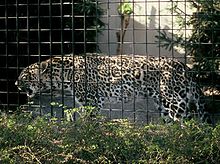



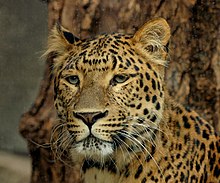
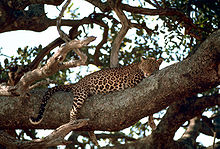
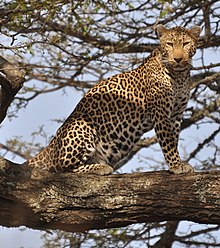









No comments:
Post a Comment